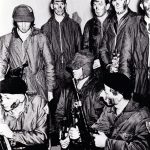
“No nation has a greater tradition of guerrilla warfare than Ireland. Our history is full of examples of its successful use. We have produced some fine guerilla leaders whose true qualities have never been fully assessed. Their strength lay in the support they received from the Irish people…
A small nation fighting for freedom can only hope to defeat an oppressor or occupying power by means of guerrilla warfare. The enemy’s superiority in manpower, resources, materials and everything else… can only be overcome by the correct application of guerrilla methods.
Guerilla warfare might be defined as the resistance of all the people to enemy power. In the struggle, the guerrillas act as the spearhead of the resistance. Up to the Second World War, the military textbooks ignored this phase of warfare. After that, they couldn’t afford to ignore it…
In regular warfare, the tactical objective is to destroy the enemy in battle by concentrating superior numbers at a decisive time and place… A regular army unit depends on all kinds of tactical support: air, ground, communication, supplies, armour, artillery, reserves, units to the left, right and rear, and so on. There are all kinds of weapons available. Plans are worked out by General Staffs, transmitted through a chain of command down the line. [Soldiers] are trained to fight as cogs in an intricate and vast machine…
The situation of a guerilla is quite different. Outside of the support he gets from the people among whom he operates – and this support must never be underestimated, for it is vital to his eventual success – he fights alone. He is part of an independent formation that is, in effect, an army by itself. He must be self-contained.
If necessary, he must act alone and fight alone wit the weapons at his disposal – and these very often will not be of the best. He must find his own supplies. His endurance has to be great; for this he needs a fit body and an alert mind. Above all, he must know what he is fighting for, and why.
The guerrilla must move fast and hit hard. He must be adaptable. He must change his methods constantly. His training must be such that during a withdrawal, his formation can break up and reform later. It is not his job to hold a line, or take a city, or maintain a strategically vital area.
But what he must do is this: He must exhaust the enemy by constant harassment. He must attack constantly and from all directions. He must stage successful retreats, return to the attack, avoid encounters with the enemy that are not of his own making.
Tactics have to be changed constantly. Formations have to be independent of terrain and lines of communication. This is what is meant by being self-contained. The guerrilla never affords the enemy a target. He is bold in the attack and his great advantage is mobility…
The guerrilla’s great weapon is surprise. To achieve this surprise, intelligence must be first-class. The guerrilla must know everything about the enemy and his battle order, his strength and his weakness, even his plans for anti-guerrilla activities. Good intelligence breeds good moral. And for the guerrilla, morale is everything. It is this morale that gives the guerrilla his determination and daring.
Once the fight is joined, it must be carried out relentlessly and to the bitter end. The road may be long, the sacrifices great, but if the guerrilla has this endurance and the will to win, he cannot be defeated.”
